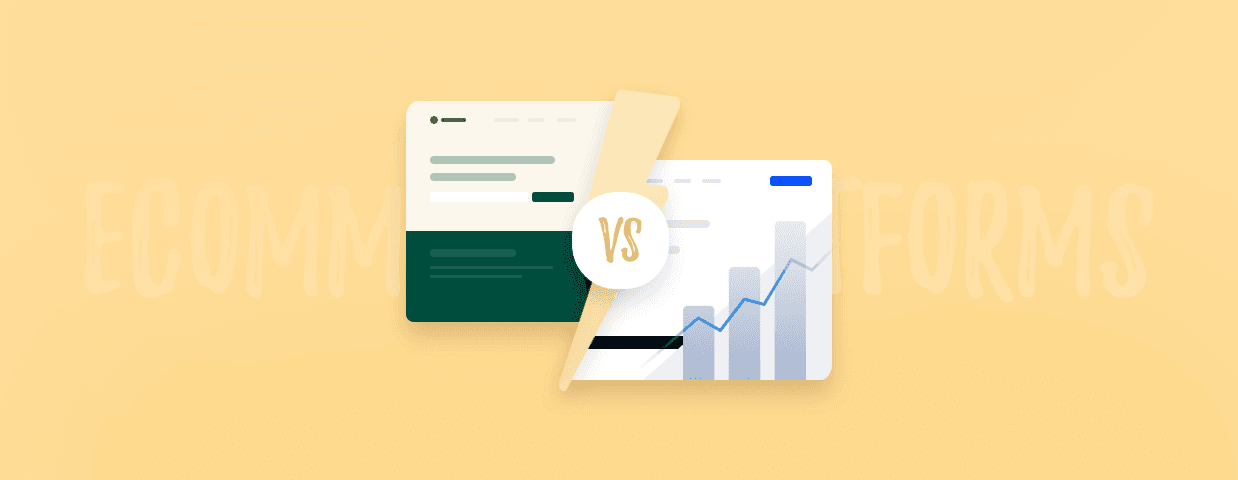There are over 200 ecommerce platforms out there. And you managed to narrow the choice down to BigCommerce vs. Shopify.
Great job!
So—
How to choose the right one for your online store?
It takes looking into both platforms, their features, functions, and reviews. But don’t worry, we know you don’t have the time for that. That’s what you got us here for.
So, let’s dive straight into the comparison of functions and features to see if BigCommerce or Shopify come at the top.
Once you've chosen your platform, don't forget to add a free live chat widget
So, let’s start by introducing the two options briefly.
BigCommerce is an open SaaS solution for building online stores. It has four plans for businesses of different sizes and supports them in creating an ecommerce store. Over 60,000 merchants are using BigCommerce for managing their online business.
Similarly, Shopify is a platform for online store building and POS (Point of Sale) systems. It is subscription-based and has five plans for businesses depending on their size and needs. Over 1,700,000 businesses are using Shopify, which provides bigger support for new users on forums and support channels.
This leads us to the market share of both platforms. Shopify takes up 27% when it comes to ecommerce websites on the entire internet. BigCommerce, on the other hand, takes less than 1% of the market.
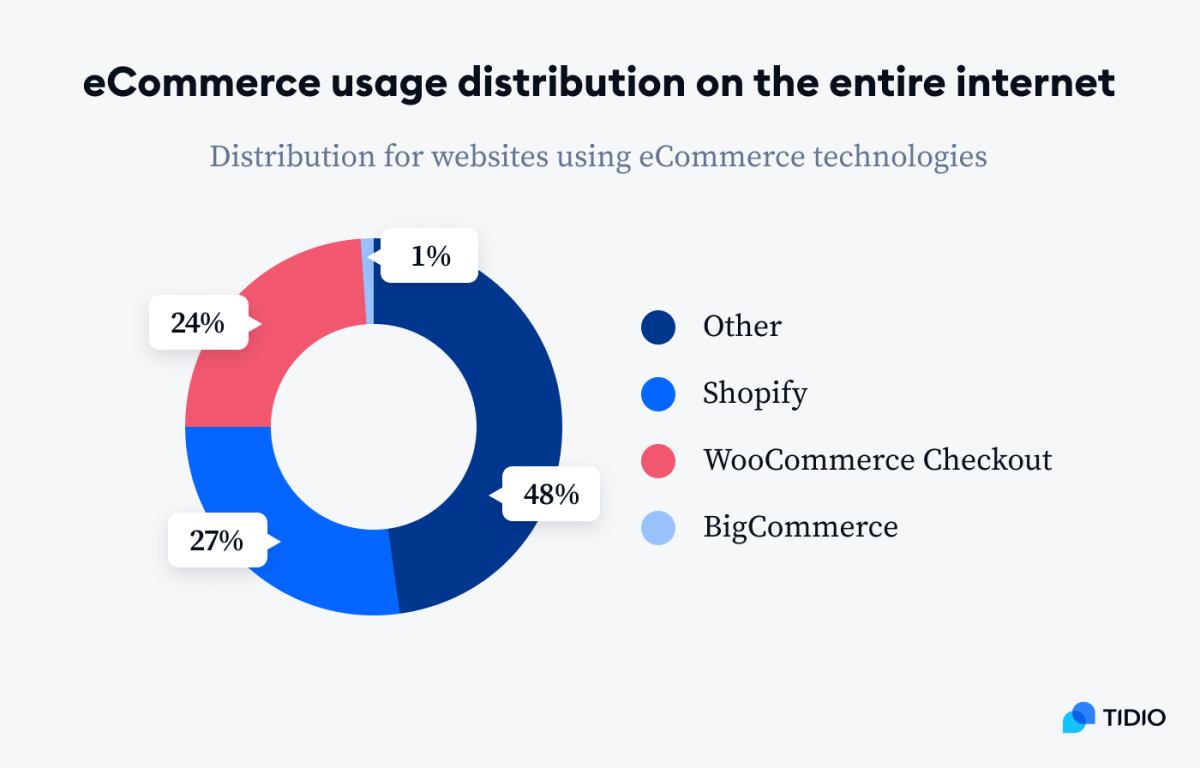
Big difference, but how do these ecommerce solutions turn out when you compare Shopify and BigCommerce reviews, features, and pricing?
Compare BigCommerce and Shopify
| Features | Shopify (11/14) 🏆 | BigCommerce (7/14) |
|---|---|---|
| Rating ⭐️ | 4.3 (3,736 ratings) 🏆 | 4.2 (393 ratings) |
| Pricing | More additional fees and fewer features included in the plans | 🏆 More features for the money & no transactional fees |
| SEO | Many SEO optimization features | 🏆 Fully customizable URL slugs and other features for SEO optimization |
| Dropshipping | 🏆 Shopify’s own dropshipping app & more dropshipping apps available | Less dropshipping apps available |
| Security | 🏆 SSL certification, PCI DSS certified, and other security measures available | 🏆 SSL certified, PCI DSS certified, and other security measures available |
| Customization | Great customization allowed | 🏆 More themes available and easier customization |
| Shopping Cart | 🏆 Free abandoned cart saver available and over 100 payment gateways | 🏆 No transactional fees and 65 payment gateways |
| Ease of use | 🏆 Easier set up | Steeper learning curve |
| Apps | 🏆 6,793 apps | 1,064 apps |
| Page speed load times | 🏆 Faster page load time | Slower page load time |
| For mobile | 🏆 Better reviews of mobile app and more features available | Fewer features available in the mobile app |
| For small business | 🏆 Better for scaling up | 🏆 Better for businesses with revenue lower than $50,000/year |
| For Facebook | 🏆 Easy integration with Facebook and Instagram available | 🏆 Easy integration with Facebook and Instagram available |
| For blogging | 🏆 More functions available for building a blog | Built-in blog available |
Let’s move on and look at all the features one by one.
BigCommerce vs. Shopify: Pricing
Winner: BigCommerce
Why?
Even though Shopify and BigCommerce have almost exactly the same pricing plans, they differ in what you get for your money. And, you just get more with BigCommerce.
So, what’s the Shopify vs. BigCommerce pricing?
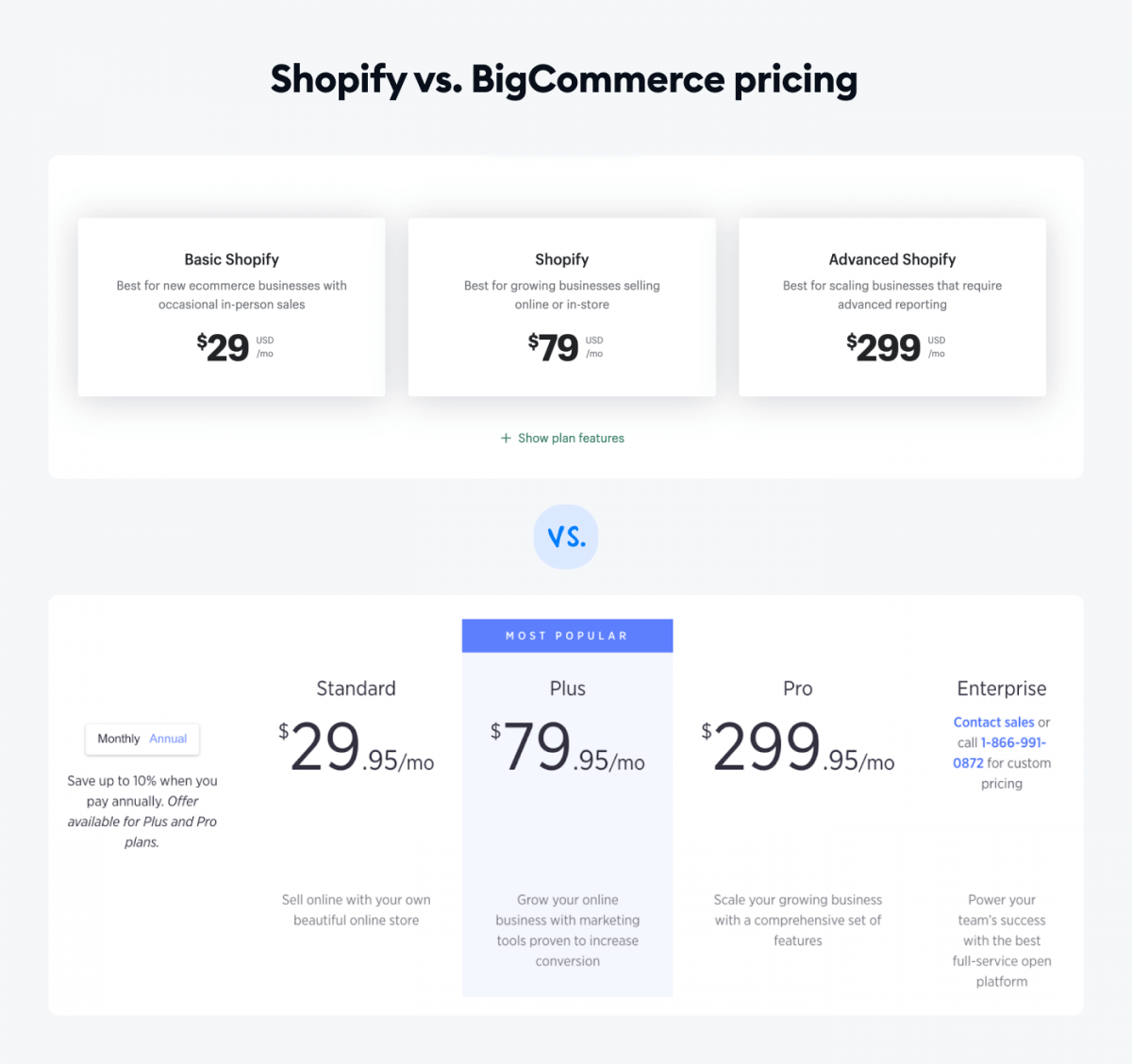
Both platforms offer a free trial. You get 14 days with the former one and 15 days with the latter. So you can see which one fits you better before committing to one.
The main features and functions that both platforms offer are unlimited products, file storage, and bandwidth. They also provide 24/7 phone support and live chat customer service so you can contact the representatives at any time you come across any issues.
The biggest advantage of BigCommerce plans is that you get features like professional reporting, a built-in ratings and reviews system, and real-time shipping rates. There is also no limit on the number of staff accounts you can create with any of the BigCommerce plans.
Even though Shopify lost this round, we need to recognize that:
- It doesn’t impose any sales limits on your store. In contrast, BigCommerce limits your sales to $50,000/year on their standard plan and $180,000/year on the Plus plan. Once you cross that limit, your business will need to upgrade the plan for the higher one.
- All the Shopify plans include an abandoned cart saver, whereas this feature is only available from the Plus plan upwards on BigCommerce.
What are the main features of Shopify vs. BigCommerce you get with each plan?
Shopify vs BigCommerce main differences in features:
| BigCommerce | Shopify | |
|---|---|---|
| Number of staff accounts | Unlimited | From 2 to 15 depending on the pricing plan |
| Transaction fees | No transaction fees | From 0.5% to 2% depending on the pricing plan (except Shopify Payments) |
| Reports | Professional reporting tools with all plans | No reports with the basic plan |
| Abandoned card recovery | Not available on with the Standard plan | Available on all plans |
| Shipping rates/ quotes | Available on all plans | Only available on the Advanced plan |
| Ratings & reviews available | Available on all plans | Not available |
As you can see from the above, BigCommerce offers more features than Shopify but it also has its limitations. So, decide what is most important for your business and look at which of the ecommerce solutions offers this in the pricing plan.
The plans aren’t the only factor you should consider when deciding which platform is more cost-effective.
Look into Shopify vs. BigCommerce costs of running your store.
BigCommerce doesn’t charge any transaction fees. Shopify, on the other hand, charges between 0.5% and 2% depending on your plan. The charges are imposed on all the transactions through third-party payment processors. That means if you don’t use Shopify Payments, you’ll need to pay the transaction fees.
In addition to transaction fees, you should also consider credit card fees. These fees depend on the company providing software for credit card processing, like PayPal, Stripe, or Amazon Pay.
BigCommerce also offers more features on a basic plan than Shopify does. This means that for some features you’ll need additional apps on Shopify which can further add to the costs of running your online store.
BigCommerce vs. Shopify price comparison table
| BigCommerce | Shopify |
|---|---|
| – Free 15-day trial – Standard $29.95/mo – Plus $79.95/mo – Pro 299.95/mo – BigCommerce enterprise-level → contact sales team – No translation fees – No limit on the number of staff accounts – Limit on sales – More features available with plans | – Free 14-day trial – Basic Shopify $29/mo – Standard Shopify $79/mo – Advanced Shopify $299/mo – Shopify Plus → contact sales team – Transaction fees charged – Limits on the number of staff accounts – No limits on sales |
Bottom line—
BigCommerce wins in the Shopify vs. BigCommerce pricing category. It imposes fewer charges, includes more features in the plans, and offers unlimited staff accounts for your business on any of their plans. Selling on BigCommerce will most likely come out cheaper than if you create exactly the same ecommerce website on Shopify.
Shopify has an additional pricing plan for $9/mo. This is their Lite option that you can use if you already have a website and want to include a Buy Button. This plan doesn’t let you build a website and only offers limited features, but it’s very cheap and may be simpler to use than building your site on Shopify.
Find out how to choose the right plan and all there is to know about Shopify pricing.
BigCommerce vs. Shopify: SEO
Winner: BigCommerce
Why?
BigCommerce wins by a small margin. Mainly because it lets you fully customize your URL slug, which is not possible with Shopify. The latter platform adds prefixes to your pages, blog posts, and products. This can be problematic for Google because it prefers shorter URLs.
Other than that, both platforms are equally optimized for SEO. You can edit page titles, meta descriptions, headings, and alt text easily.
You can also create automatic 301 redirects when you change a page’s URL. This is important because it redirects visitors from the old URL to the new one so they can still access your content. And, it helps to replace the old page in the search engines index with the new page.
Both sites are also fully responsive. This helps to keep your website’s appearance for visitors visiting your store on laptops, tablets, and mobile devices. And it also helps your SEO because search engine algorithms prefer a mobile-first design, so it can give you a little head start over the competition.
Another feature helping your website with SEO is the sitemap available on both platforms. Sitemaps help Google crawl your site more efficiently which can help you rank better in the search engine result pages.
Shopify vs. BigCommerce SEO features comparison
| BigCommerce | Shopify |
|---|---|
| – Fully responsive – Sitemap available – Add alt text to images – Fully customizable meta titles, meta descriptions, and URL slugs – Automatic 301 redirect – Modify page titles, headings, etc. – Free SSL certificate | – Fully responsive – Sitemap available – Add alt text to images – Fully edit meta titles and meta descriptions – Automatic 301 redirect – Modify page titles, headings, etc. – Free SSL certificate – URL not fully customizable |
Bottom line—
Both sites are a great choice for SEO, but BigCommerce wins this round because it allows you to customize your URLs more effectively. It provides this personalization alongside all the other features that Shopify provides.
One thing you should remember is that all the elements above are just part of the so-called technical SEO. You need much more than that to rank well on search engine results. You need to invest time and effort in creating great content for your pages.
Read more: Is Shopware Ecommerce SEO-Friendly?
BigCommerce vs. Shopify: Dropshipping
Winner: Shopify
Why?
As far as dropshipping is concerned, Shopify beats BigCommerce as it offers more dropshipping apps. This gives your business more options to choose from.
Shopify also has its own dropshipping app, Oberlo. You can use it to source products from suppliers, import them to your store, edit the listings, and place orders. This makes the process of dropshipping a little easier for you.
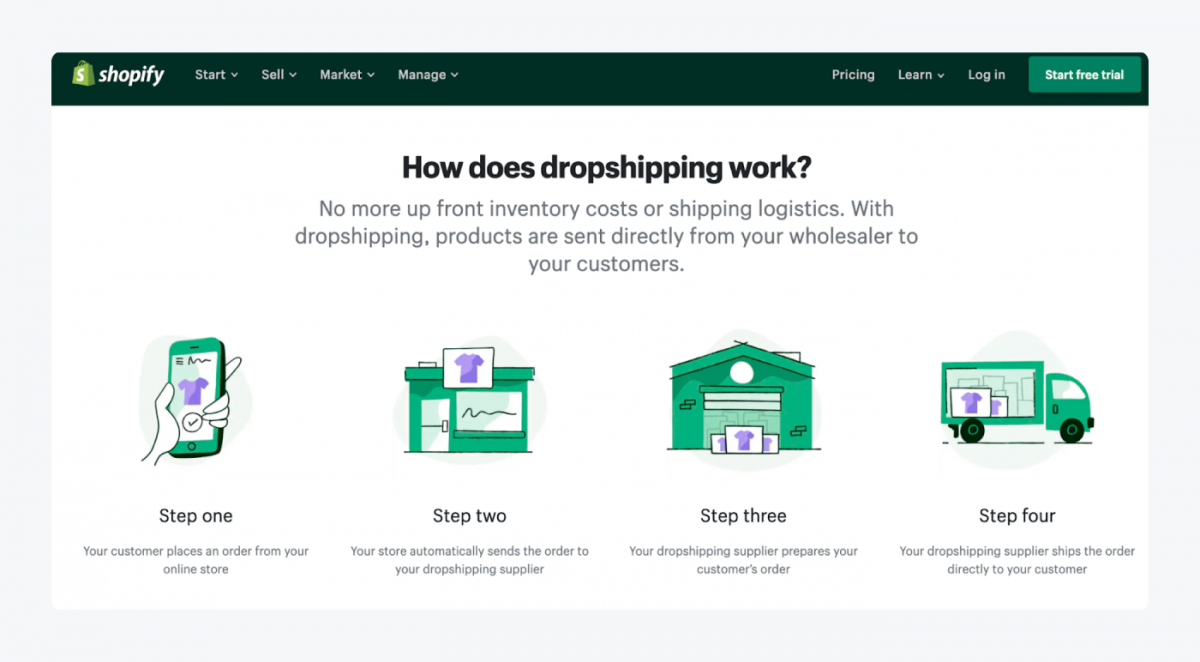
BigCommerce has dropshipping apps as well, but there are fewer choices, and they’re all third-party suppliers. The fulfillment process is therefore outsourced to a third-party wholesaler, manufacturer, or supplier.
BigCommerce vs. Shopify dropshipping comparison
| BigCommerce | Shopify |
|---|---|
| – 24 dropshipping apps | – 314 dropshipping apps – Shopify’s dropshipping app Oberlo |
Bottom line—
Shopify gives you more choices and more control over your dropshipping business. This ecommerce provider has over ten times more options so you are more likely to find one that matches your business needs.
Find out more about Shopify dropshipping, how it works, and some tips from store owners.
BigCommerce vs. Shopify: Security
Winner: it’s a draw
Why?
Both BigCommerce and Shopify take security very seriously, so your store is safe in their hands. Choosing a clear winner wouldn’t be fair since both platforms offer the same security measures.
They offer free SSL certificates on all plans, so the information (credit card details, user names, passwords, etc.) on your site is encrypted. This decreases the risk of the information being stolen or tampered with.
Both platforms are also PCI DSS compliant, so whichever you use, your store will automatically be PCI compliant as well. This means that both BigCommerce and Shopify meet the Payment Card Industry Data Security Standards requirements and protect your customers from credit card data breaches.
Both platforms also provide other internal security measures, such as HTTPS protocol, perimeter, and server-specific firewalls, file integrity scanners, intrusion detection software, 24/7 human monitoring, DDOS mitigation solution, etc.
BigCommerce and Shopify guarantee 99.99% uptime and unlimited storage capacity. Your website is also protected by an automatic backup system in case anything goes wrong.
And if you do notice something is wrong on your Shopify store, you can report it to Shopify’s HackerOne page so they can look through it and fix the issue.
Comparison of Shopify vs. BigCommerce security:
| BigCommerce | Shopify |
|---|---|
| – Free SSL certificate on all plans – PCI DSS 3.0 certified at Level 1 – HTTPS security – Unlimited storage capacity – 99.99% uptime guaranteed – Other internal security measures | – Free SSL certificate on all plans – PCI DSS 3.0 certified at Level 1 – HTTPS security – Unlimited storage capacity – 99.99% uptime guaranteed – Other internal security measures |
Bottom line—
Both platforms have high-security measures in place. They are equally great and will keep your online business safe.
BigCommerce vs. Shopify: Customizability
Winner: BigCommerce
Why?
First and foremost, there are over 170 BigCommerce themes. In contrast, Shopify has only about 80 themes available. Each theme on both platforms has from two up to four different styles.
When comparing BigCommerce vs. Shopify theme customization you’ll see that they allow a great deal of it. Both platforms let you personalize the storefront of the theme you pick, from colors and fonts to changing the HTML/CSS code. And you can also switch your theme at any time with Shopify and BigCommerce.
Even though Shopify lost this round, we have to give it credit for a large range of fonts you can access on any of their themes. There is a mixture of Google fonts, licensed fonts, and web-safe fonts available. And you get all of them out of the box with every theme you get on Shopify. BigCommerce fonts, on the flip side, are limited when it comes to free themes.
BigCommerce vs. Shopify theme customization comparison table
| BigCommerce | Shopify |
|---|---|
| – Over 170 themes (12 free themes, 158 paid themes) – Great customization – Customizing HTML/CSS code allowed – Change of theme any time – Up to 600 variations for each product | – Over 80 themes (10 free themes, 70 paid themes) – Great customization – Customizing HTML/CSS code allowed – Change of theme any time – More fonts available with any theme – Up to 100 variants for each product |
Bottom line—
BigCommerce is the winner in this category because of the larger variety of themes available. It has more than twice as many themes as Shopify so you get a better choice and can pick the perfect one for your online business.
Shopping carts: Shopify vs. BigCommerce
Winner: it’s a draw
Why?
Let’s first look at Shopify vs. BigCommerce abandoned cart recovery features. Both platforms provide automated abandoned cart emails. You can schedule and send three follow-up emails on a BigCommerce store. Shopify stores can only send one abandoned cart recovery email.
But—
You need to be at least on a Plus plan that stands at $79.95/mo to use that feature with BigCommerce. In comparison, Shopify provides abandoned cart emails with all its pricing plans. And a limitation with Shopify is that you are only allowed to send one automated email at a specific time interval: 1 hour later, 6 hours later, 10 hours later, or 24 hours later.
Another aspect of a shopping cart we should take into consideration is the payment methods both platforms offer.
Shopify has over 100 payment gateways available, so your customers get a wide choice of credit card payment solutions. BigCommerce offers, as of writing this article, 65 pre-integrated payment gateways.
This looks like a win for Shopify but we must remember that Shopify charges transaction fees on all payment gateways other than Shopify Payments. In contrast, BigCommerce doesn’t charge transaction fees on any of them.
Last but not least: Shopify versus BigCommerce order status for customers. Both platforms allow your customers to check their order status as well as send an email when the order is placed. They also let you create customized emails if you want to include a tracking number, a discount code, or any other information.
Shopify cart vs. BigCommerce cart comparison
| BigCommerce | Shopify |
|---|---|
| – Abandoned cart saver available on plans starting from $79.95/mo – Three automated follow-up emails available – No transaction fees 65 pre-integrated payment solutions – Customizable order confirmation emails | – Abandoned cart saver available on all plans – One abandoned cart saver email available – Transaction fees on payments other than Shopify Payments – Over 100 payment gateways – Customizable order confirmation emails |
Bottom line—
This section is a draw because both platforms provide great features for your shopping cart. They both offer abandoned cart emails. BigCommerce offers more but also charges more for it.
They also both have many credit card payment options. Shopify has more but also charges transaction fees, whereas BigCommerce doesn’t.
Check out some of the best apps for saving abandoned carts on Shopify to improve your strategy and decrease abandoned cart rates.
BigCommerce vs. Shopify: Ease of use
Winner: Shopify
Why?
Shopify is easier to use than BigCommerce. Setting up your website is straightforward. Adding products boils down to filling out a quick form, and you get useful sales tips along the way. This makes Shopify ideal for beginners and those who don’t have a lot of experience with building sites.
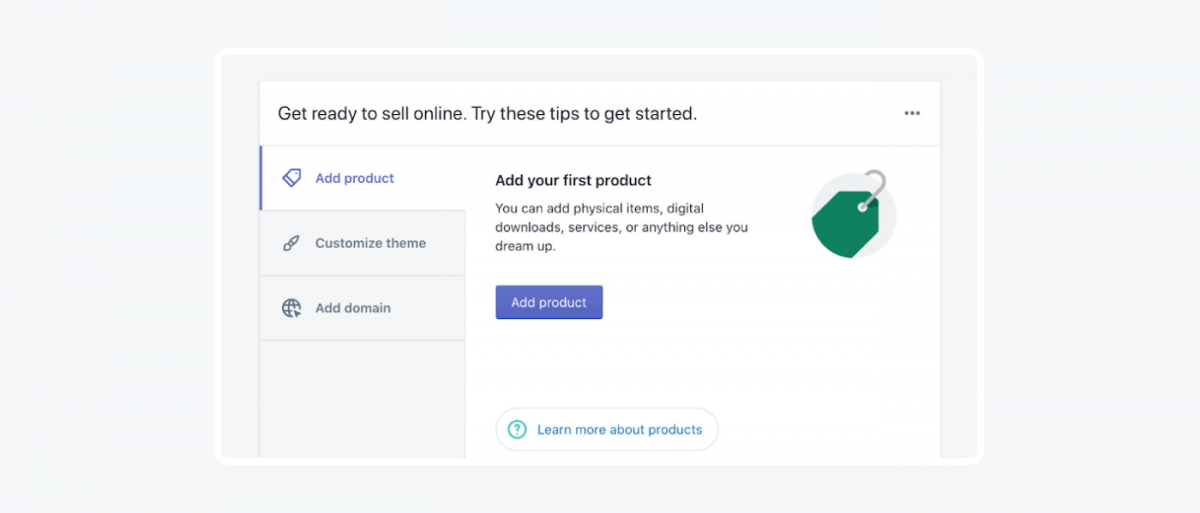
You also get a dashboard that is ideal for keeping your store’s products and sales information organized.
The learning curve is a little steeper with BigCommerce. This is because it offers more powerful sales features, and it uses various technical terms. You might need to spend some time researching specific terms when doing even the most basic tasks.
Also, the customer onboarding process on Shopify is superior to BigCommerce. Shopify gives users videos, checklists, and a knowledge base to help them get started.
A bonus point for BigCommerce is the drag-and-drop builder. Shopify doesn’t offer that feature, which makes it a little less user-friendly. On Shopify, you can switch the order of page elements from a list, but you can’t place them wherever you want on the page by dragging them there like you can on BigCommerce website builder.
User experience Shopify vs. BigCommerce comparison
| BigCommerce | Shopify |
|---|---|
| – Steeper learning curve – Drag-and-drop builder – Use of various technical terms | – Easier to set up – Great customer onboarding – Use of simple terms |
Bottom line—
This one goes to Shopify. Even though both platforms are straightforward and easy to use, Shopify offers a simpler setup of your website and a better user experience for beginners.
Learn step-by-step how Shopify works and all you need to know to start your store on the platform.
Apps: BigCommerce vs. Shopify
Winner: Shopify
Why?
Shopify’s app store has about six times more apps available than BigCommerce. There is an app for anything and everything you might need when building and managing your store.
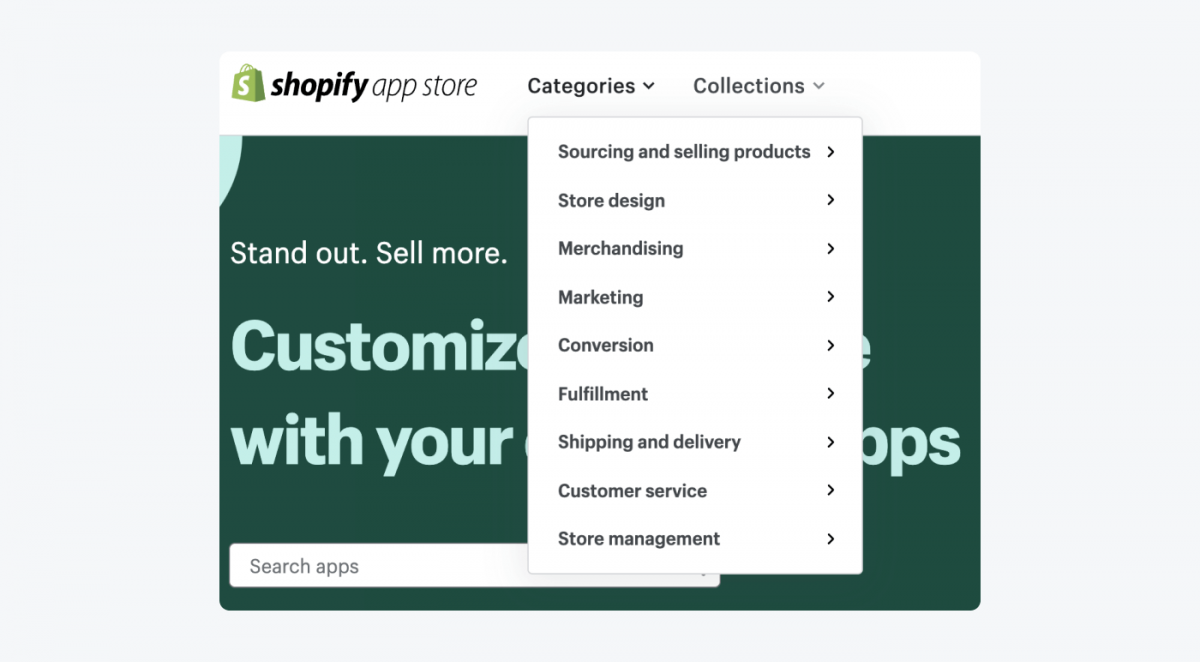
Some of the top Shopify apps for your store include Tidio Live Chat for Shopify, Oberlo, and ReferralCandy. Shopify has apps for all of your store’s additional needs, so you can customize it in every which way.
The variety of apps available on Shopify are designed to enhance the experience your customers get and increase your ecommerce sales. These apps can help you with customer support, SEO, and other areas of your business.
The number of Shopify apps available on their store also reflects the bigger user base and ecosystem built around Shopify.
Comparison table of apps on Shopify and BigCommerce
| BigCommerce | Shopify |
|---|---|
| – 1,064 apps | – 6,793 apps |
Bottom line—
The number and variety of apps available on Shopify beat BigCommerce apps by a large margin. Whatever additions you want to add to your store, you’ll definitely find them as plugins and apps on Shopify.
Learn how to install Tidio on Shopify and how to install Tidio on BigCommerce.
BigCommerce vs. Shopify: Page speed load times
Winner: Shopify
Why?
As the page load time increases from 1 second to 3 seconds, the probability that a page visitor will bounce increases by 32%. And a high bounce rate is not a good thing for a website or your business.
To avoid frustrating your shoppers, you need a fast page, and Shopify wins on that front. Simply put, Shopify is faster. It loads at an average of 1.3 seconds in comparison to BigCommerce’s average of 2.6 seconds.
BigCommerce vs. Shopify speed comparison table
| BigCommerce | Shopify |
|---|---|
| – Slower – Google Cloud Platform – Google AMP supported | – Faster – Shopify online store speed report – Google Cloud Platform |
Bottom line—
Shopify wins because its page load times are roughly twice faster than BigCommerce. So, even though BigCommerce supports AMP by default, the results you get from Shopify are still better. And you can also use apps for Google AMP on Shopify if that’s an important feature for you.
Shopify vs. BigCommerce: For mobile
Winner: Shopify
Why?
Both Shopify and BigCommerce have responsive templates that adjust the layout according to the device your customers use.
Shopify has better mobile apps that are available on both iOS and Android. It has a Shopify app and Shopify POS app. Both apps allow you to manage most of the functions of your ecommerce store from your phone, like fulfilling orders, adding products, viewing reports, accepting credit card payments, etc.
You also get additional apps available with Shopify, like a customer chat app, logo maker, order tracking tool, etc. They can help you with various aspects of setting up and managing your store on the go.
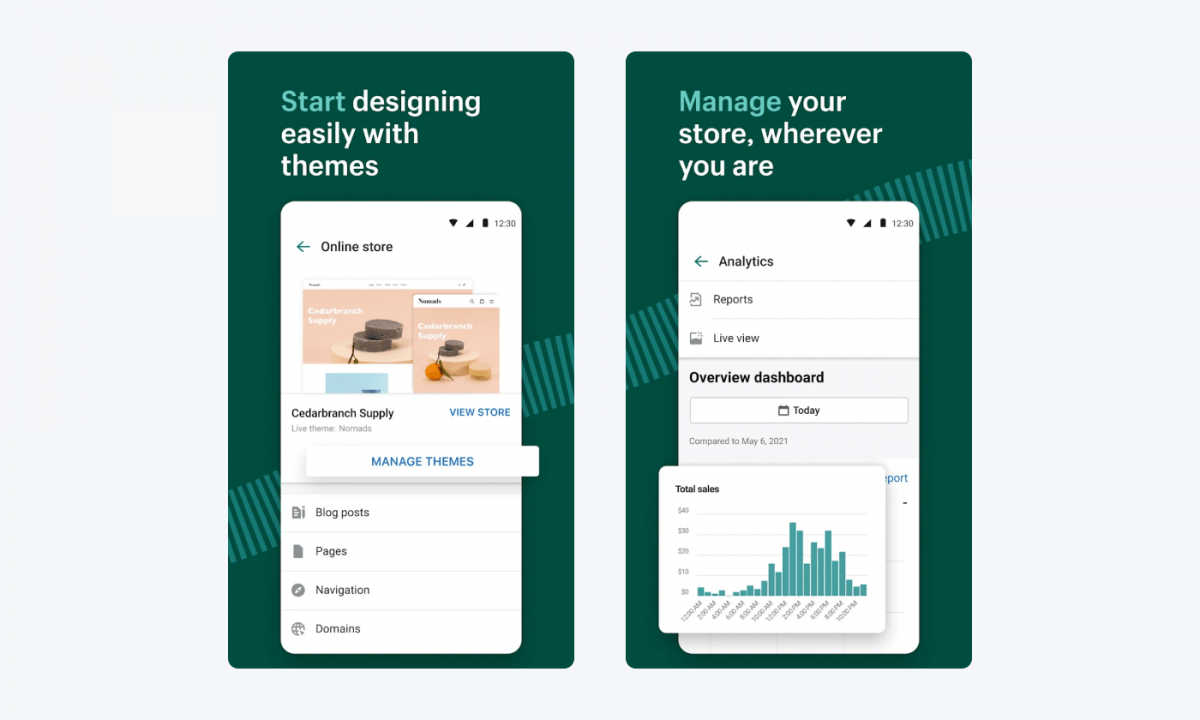
BigCommerce, on the other hand, only provides a mobile app that helps you manage orders, view basic statistics, and contact customers. There are no additional apps like POS available.
When it comes to AMP (Accelerated Mobile Pages), BigCommerce allows them by default, and Shopify has third-party apps for that purpose. Both allow you to present your product pages in AMP format on any of the templates.
Shopify vs. BigCommerce for mobile comparison:
| BigCommerce | Shopify |
|---|---|
| – iOS ratings for mobile app: 4.6 ⭐️ (493 ratings) – Android ratings for mobile app: 3.5 ⭐️ (176 reviews) – AMP by default – Limited features on a mobile app | – iOS ratings for the mobile app: 4.6 ⭐️ (7,600 ratings) – Android ratings for mobile app: 4.4 ⭐️ (19,931 reviews) – Third-party apps needed for AMP – Extensive features on a mobile app |
Bottom line—
Shopify has a better mobile app and allows store owners to manage their ecommerce on the go. Both have templates with a responsive layout to match the device customers use to access your online store.
Learn how to make a logo for your business in a few easy steps and what resources you can use to help you with making it.
Shopify vs. BigCommerce: For a small business
Winner: BigCommerce
Why?
This one is tricky since both platforms offer great services for small businesses.
Let’s put it this way: BigCommerce is better for businesses with revenue lower than $50K/year because of better features with their plan. Shopify is easier to implement and is better for businesses that want to scale up in the near future.
With BigCommerce, when you cross that $50K/year revenue, you’ll automatically be moved up to the $79.95/mo plan. Shopify doesn’t change your plan no matter what revenue you make, so you have more freedom when growing your business.
But, BigCommerce lets you choose your payment processor without charging transaction fees and allows you to have an unlimited number of staff accounts.
On the other hand, Shopify lets you implement a Buy Button on your existing site and use their inventory features for a physical store with a Lite plan for $9/mo.
Both platforms have their limits: Shopify restricts the number of staff accounts you can add by plan, whereas BigCommerce plans have revenue limits.
Shopify vs. BigCommerce comparison for small business owners:
| BigCommerce | Shopify |
|---|---|
| – Better for businesses with revenue lower than $50K/year – Unlimited accounts – No transaction fees | – Better for scaling up – Easier to implement – Shopify Lite for physical stores and other existing sites |
Bottom line—
You should choose BigCommerce if you have a small business and want to have the freedom of choosing a payment gateway and have as many accounts as you wish. But most importantly, you should consider if you want to grow your business beyond the $50/year and therefore jump up to the higher pricing plan.
Discover the best lead generation strategies for small businesses and bring more traffic to your website.
BigCommerce vs. Shopify for Amazon sellers
Winner: Shopify
Shopify supports Amazon, eBay, and several other online sales channels, making it easier for you to integrate your ecommerce store with them. You can link your Amazon products to your Shopify store. This means that you can sell your existing products on both platforms.
And, for more convenience, you can accept payments through Amazon Pay. A little catch is that you will have to pay a transaction fee each time a customer makes a purchase through Amazon Pay.
Both platforms let you connect your website to automate order fulfillment on Amazon. This allows you to use Amazon to sell the products from your store.
A bonus point for BigCommerce is that it allows you to sell on other ecommerce apps, like Google Shopping, Walmart Shopping, and PriceGrabber.
Shopify is a better option for Amazon sellers because the integration is more seamless. You get to connect your products from your Shopify store onto Amazon and vice versa.
Shopify vs. BigCommerce for digital products sales
Winner: BigCommerce
When it comes to selling purely digital and downloadable products, BigCommerce is better equipped for the job. It has built-in options for selling digital products, and it makes it easier for users to add their downloadable content to their shop.
On Shopify, you need to install a separate app for selling digital downloads, and it’s not as easy to use as the competitor.
That’s why BigCommerce wins a Shopify vs. BigCommerce clash for downloadable products.
BigCommerce vs. Shopify on Facebook & social media
Winner: It’s a draw
Why?
Both Shopify and BigCommerce let you integrate your store with Facebook and Instagram.
You can easily set up and manage catalogs, create ads for your products, and offer sales onsite. Both platforms let you sync your product catalog automatically to create shoppable posts. This can help you market your products in front of a bigger audience and attract more shoppers to your store.
Your customers can complete their order and checkout entirely within your social media page. You can manage your orders with Facebook and Instagram and sell directly through these platforms.
Compare BigCommerce vs. Shopify for Facebook
| BigCommerce | Shopify |
|---|---|
| – Customize your Facebook Shop – Create collections – Product tags – Consistent in-app shopping experience – Checkout on Facebook & Instagram – Add a discount code to your social posts – Facebook ads – Track customer actions on your online store with Facebook pixel – One-tap checkout | – Customize your Facebook Shop – Create collections – Product tags – Consistent in-app shopping experience – Checkout on Facebook & Instagram – Add a discount code to your social posts – Facebook ads – Track customer actions on your online store with Facebook pixel – One-tap checkout |
Bottom line—
Both platforms offer great integration with Facebook and Instagram. No matter which one you choose for your store, you can show your products and sell them on social media. You can also easily market items and your brand with Facebook Ads and product posts.
Learn how to sell on the Facebook marketplace effectively with some tips and tricks.
BigCommerce vs. Shopify: For blogging
Winner: Shopify
Why?
Because you get more options when creating your blog on Shopify.
Both platforms let you add a blog to your site. But, Shopify also lets you make e-newsletter signup forms, contact forms, and blog post strips.
You can also customize your blog more on Shopify by setting up a specific publication date and publishing many blog posts simultaneously. Shopify also makes it easier for you to invite your customers to subscribe to your blog by automatically creating an RSS feed for each of your posts.
Both platforms allow you to integrate a blog from a different platform onto your site. They also both provide features, such as tags and blog excerpts. Having a blog on your business website can prove very useful since companies with blogs produce about 67% more leads than companies without an integrated blog.

Compare Shopify vs Bigcommerce for blogging:
| BigCommerce | Shopify |
|---|---|
| – Build-in blog – Blog excerpt – Social sharing button – Comments – Tags Integrations with third-party blog | – Build-in blog – Blog excerpt – Social sharing button – Comments – Tags – Set a specific to publish date for a blog post – Publish blog posts in bulk – Automatic RSS feed produced for every blog created – Integrations with third-party blog |
Bottom line—
Either platform will be good for building a simple blog on your website. Shopify takes the trophy in this round because of the additional features it provides in comparison to BigCommerce. You get more support when importing blog posts and building your list of subscribers when you use Shopify.
Nevertheless, whether you choose to blog on Bigcommerce or on Shopify, the capabilities for blogging of both platforms can be further enhanced with additional tools that can be easily integrated into the platforms. This will enable you to have a blog with many more functionalities and customizations available.
Read more: Learn what are the top Shopify competitors and alternatives to choose the right one for your brand.
FAQ
The short answer is yes. You can migrate BigCommerce to Shopify.
1. First, you’ll need to install an app to enable migrating from BigCommerce to Shopify. So, go to Shopify App Store and install Store Importer onto your site.
2. Then, export your data from BigCommerce. This will download CSV files with your products, customers and order data onto your computer.
3. When the download is finished, you can upload any number of CSV files onto your Shopify store with the help of the Store Importer app. Make sure you import all your products, customers, and other store data to Shopify.
4. Last but not least, review and update the data you imported. Make sure all your products, customers, and other data are now available in your Shopify admin.
Yes. BigCommerce is an ecommerce platform on which you can build your online store.
They provide many payment options for your customers, all the security requirements to make your store safe, and many features to build your store the way you want to. There are also over 1,000 apps available on their Market app store, so you can add any functions your business requires.
You don’t need a developer to build an online store on Shopify or BigCommerce.
Both of these platforms are designed so that anyone can build and manage their own ecommerce easily. They are aimed at people who don’t have coding skills or experience. You don’t need to write a single line of code when building your online store if you don’t want to.
The top three alternatives to BigCommerce and Shopify are:
1. WooCommerce
2. Adobe Commerce (formerly Magento)
3. Wix
Summary
So, who is the winner in the BigCommerce vs. Shopify battle?
Shopify comes on top this time. It’s faster, has more powerful features, and offers almost unlimited functions with the use of thousands of apps.
But it all depends on what’s most important for your online store. Because maybe you want to have an unlimited number of staff accounts or get the theme matching your company’s style.
So, decide what you’re most vital for your ecommerce store and see which platform matches your needs better. And don’t hesitate to make use of the free trial that Shopify and BigCommerce offer to see which one feels better before committing to any.
